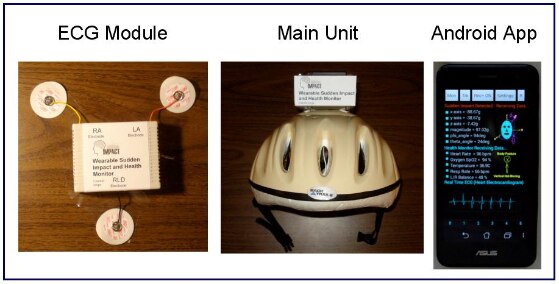The decision for our grand prize winner was not an easy one to make after considering the results from Leeds Beckett University and a detailed review of the complete content for each project.
The Sudden Impact Grand Prize Winner is Cosmin Iorga!
Cosmin's winning build features a main helmet unit that measures head impact, body temperature, tilt, global positioning and even brain activity. A separate electrocardiogram chest module measures heart rate and both units provide data and alerts to an Android smartphone app. I had the opportunity to chat with Cosmin and discuss the challenge and his reaction to finding out he won.
element14: What was your reaction to winning?
Cosmin: I felt great; it was a mixture of intense happiness, satisfaction, and gratitude, immediately followed by an energy suddenly released, the energy that has been building up gradually for the past weeks while following the project testing updates from Leeds Becket University.
element14: What part would you consider the most fun of the project?
Cosmin: Probably the most fun part of the project was the exploration of what each of the received Analog Devices modules and sensors can do, the experimental work on connecting and controlling them to make them functional, and the thinking on how to use these modules and sensors in a creative way in my project.
element14: What was the most challenging?
Cosmin: Definitely there were a lot more challenging than fun moments in working on this project. I would like to mention as challenging the interpretation of accelerometer measurements recorded during a sudden impact. At the beginning the x,y, and z axis values were all over the place and did not make much sense. Then I post-processed them in spreadsheets and I went through an intuitive analysis of what happens in an impact and how to relate what happens to the measured acceleration. An important fact that I realized was that the mechanical properties of the human body part that receives the impact has a significant effect on the damage produced by the impact and on the acceleration values that are measured. My analysis had to go back to refreshing my knowledge about collision theory and balance between elastic and inelastic collisions. After that, things started to make sense and I could explain what I saw through a dynamic interrelation between action and reaction force pairs.
I would also like to mention another challenge or maybe I better would say "stressful situation". Part of my project initialization was to setup the communication between a smartphone and the TK102 tracker that I modified into a GSM modem. In order to enable this communication the phone number of the smartphone has to be added into the GSM modem as an authorized number. This is done through sending a sequence of commands in the format of SMS text messages from an already authorized smartphone. So here I am in California trying to remotely program the GSM modem on my project to authorize the smartphone number received from Professor Reinhold Behringer that was planned to be used at Leeds Beckett University in United Kingdom for testing my project. At that moment I realized that my project has learned my phone number without the U.S. country code, which worked well here in U.S. but not in U.K. The GSM modem received my SMS text commands from my phone number with the U.S. country code appended, and did not want to recognize my number anymore. I felt lost, but then I remembered that the first phone number authorized in that GSM modem was entered with the country code (my wife's phone number), so I picked up that phone and I was happy and relieved to see that it was recognized by the GSM modem and I could add the new authorized number. The stress has dissipated for a few moments but it came back when I realized that I did not add a zero in front of the number, as I read on the Internet that it is placed when dialing local numbers in U.K. So I tried to add the number as a different authorized number this time with a leading zero in front, but to my surprise I was no longer able to communicate with the GSM modem. The reason was that the GSM modem can store only five numbers as authorized numbers, and the newly added number received from Professor Reinhold Behringer "pushed" out of memory my wife’s phone number, and that was the only number added with U.S. country code. At that moment I felt like I lost contact with a space rover on Mars or another planet. But luckily, as I then learned from Professor Reinhold Behringer, the first number without the leading zero worked well, and they were able to establish communication with the GSM modem and receive data from my project.
element14: What other builds did you follow along with in the challenge?
Cosmin: I followed from the begging all the updates posted by the challenge participants. I liked the quality of blog posts and the detailed descriptions of various issues and accomplishments, and I particularly liked to read what Doug and Ravi have posted.
element14: What advice would you give to other members who are doing, or thinking of doing a design challenge?
Cosmin: My advice to current and future challenge participants is to be confident on themselves, to approach the challenge with an "out of the box" creative thinking, and to do all the best they can to create strong projects.
element14: Thanks Cosmin, congratulations on the winning project!
Cosmin: I wanted to say thank you to element14, the sponsors of this design challenge and my fellow competitors in this Design Challenge.
The Grand Prize includes a Tektronics MDO-3104 Oscilloscope, MacBook Air and a Withings Home HD Sensor Kit.
5)
In addition to the Grand Prize, we are pleased to announce the runner up as...
Ravi Butani of India!
Ravi built a real-time player monitoring system. He will be receiving a CEL-Robox 3D printerCEL-Robox 3D printer.
In November of 2014 the element14 Community challenged 12 members to help develop a low cost, wearable device to help monitor measure and alert the user of the potential dangers associated with athletics. The Kit each Challenger received included components from Analog Devices, a Tektronix oscilloscope, advanced polymers from Electrolube and a $500 budget from Premier Farnell for additional parts and purchases.
Upon the completion of their projects the challengers shipped their projects to Leeds Beckett University in the UK to have their build tested in a laboratory environment. This was the first time project submissions from an element14 Design Challenge were sent out for third-party testing.
Element14 would like to say “thank you” to Professor Reinhold Behringer and his team at Leeds Beckett University for their evaluation. Attached you will find the criteria for the evaluation and scoring methodology. There is also a scoring sheet of the six challengers who submitted their final project for testing.The other Sudden Impact projects were:
- a real-time coach and athlete monitoring system from Austin Horning in the U.S.;

- a sudden impact helmet and uniform sensor system by Dragan Knezevic in Serbia;
- a helmet-mounted ski monitor from Hendrik Lipka in Germany;
- a helmet-mounted trauma monitor and heart reactor by Douglas Wong in Canada.
All of the Challengers who submitted their projects for testing will be receiving a Withings Plus Sports Watch as a thank you.
Thanks again to all of our Challengers. Make sure to stay up current with the latest Design Challenge news at element14.com/designchallenges






Top Comments
-

hlipka
-
Cancel
-
Vote Up
+1
Vote Down
-
-
Sign in to reply
-
More
-
Cancel
-

element14Dave
in reply to hlipka
-
Cancel
-
Vote Up
+1
Vote Down
-
-
Sign in to reply
-
More
-
Cancel
-

hlipka
in reply to element14Dave
-
Cancel
-
Vote Up
+2
Vote Down
-
-
Sign in to reply
-
More
-
Cancel
-

element14Dave
in reply to hlipka
-
Cancel
-
Vote Up
+2
Vote Down
-
-
Sign in to reply
-
More
-
Cancel
Comment-

element14Dave
in reply to hlipka
-
Cancel
-
Vote Up
+2
Vote Down
-
-
Sign in to reply
-
More
-
Cancel
Children